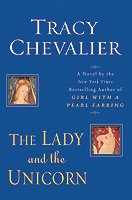


 |
Issue Contents :: Bookshelf :: Page [ 1 2 3 ]
Featured Book: The Lady and The Unicorn
 |
The Lady and the Unicorn
By Tracy Chevalier '84
Dutton, 2004
The unicorn is a mythic figure with a remarkable history. In the Middle Ages, its fabulous attributes—purity, bravery, unrivaled swiftness, susceptibility to virginal women, and the curative powers of its long spiral horn—gave it irresistible appeal as a manifestation of the symbolic lessons subtly concealed in the natural world. For religious purposes, it stood as an emblem of Christ; in the deliberately allusive code of romantic love, it represented the ardent and worthy lover.
A magnificent set of medieval tapestries, woven in Brussels and now on display at the Musèe de Cluny in Paris, proclaims the attractiveness of this mythic figure. Richly ornamented with animal and floral representations, its six panels employ a unicorn and a well-dressed lady against a warm red background to portray allegorically each of the five senses. In the sixth panel, the lady is either placing into or taking from a strongbox a cloth full of sumptuous jewelry, while she stands within a pavilion inscribed with the legend a mon seul desir (to my only desire).
Tracy Chevalier has been captivated by these splendid textiles and by the challenge of decoding the meaning that they so artfully conceal. In response, she has fashioned a novel that is itself a richly textured work of art. Drawing on what is known about the provenance of the tapestries and the craft of weaving in the late 15th century, she has woven a narrative account of their making and significance that connects artistry and symbolism with flesh and blood.
She imagines a Parisian painter, Nicolas des Innocents, who is commissioned by a social-climbing nobleman to design tapestries that will soften the stone walls of his great hall (and, coincidentally, display his wealth and nobility). Nicolas' subject—the Lady and the Unicorn of the title—arises from his frustrated passion for the nobleman's spirited daughter. The tapestries are then woven from the painter's designs by a Flemish workshop in which the randy Nicolas lusts after the master craftsman's daughter. One of his amorous desires is thwarted by maternal ruthlessness; the other succeeds on account of maternal distraction.
The novel unfolds, aptly, in five temporal segments within which the principal characters share the task of telling the story. Just as each of the ladies in the tapestries is distinctive, the women whose voices are heard in the novel are very different. Those differences provide a fascinating reading of the tapestries and provoke an enigmatic tissue of conflicted desires that teases the contemporary reader into reflection. Such reflection both illuminates the elusive meanings hidden within the tapestries and complicates them by offering glimpses into the concealed arsenal of human desire.
Chevalier writes with sentient grace, and human history invigorates her powerful imagination. The Lady and the Unicorn, like each of her three earlier novels, testifies to her literary power and distinction.
Robert Longsworth is an emeritus professor of English at Oberlin.
Read an interview with Tracy Chevalier